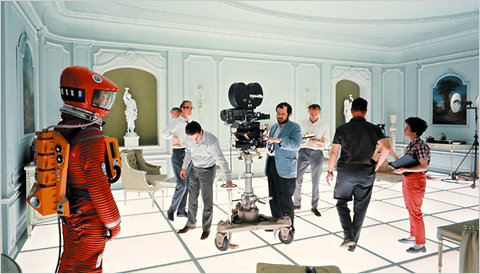Stanley Kubrick was a hoarder.
When we think about Kubrick, we see mighty power, the furious terror behind his eyes, the overbearing vision of his cinematic output. Never do we consider that the man behind the awe-inspiring filmic collection was subject to obsessive tendencies. Now, it seems, the visionary who was capable of condensing the entirety of space and time into a three hour feature was also favourable to some lightly loopy behaviour, stockpiling his entire cinematic research into an archive containing over one thousand boxes.
In 2008, documentary maker and journalist Jon Ronson released the television documentary Stanley Kubrick’s Boxes, a very small and very surprising biographic snapshot of the late director’s life and cinematic approach. Reformatting the traditional documentary biography, Stanley Kubrick’s Boxes looked somewhat away from the intricate private life of the director and instead focused its gaze on something somewhat smaller: His collection of boxes.
Of course, this being Stanley Kubrick, it’s not as simple as labelling the man as a hoarder. The majesty of Kubrick cannot be condensed to a single title and left to fester. Kubrick did not merely hoard boxes, he filled them with acres and acres of paperwork, research, fan letters, photographs and cinematic ideas. In short, Kubrick amassed and created an archive of his creativity.
As Ronson pores through the endless layers of Kubrick’s archive, it’s unclear to tell what he makes of it all. When he first enters the archive, he is obviously taken aback. The sheer mass of the collection is overwhelming and to consider that it had been meticulously cared for by such an unforgiving presence as Kubrick seems, well, a little ludicrous. And yet, the further Ronson makes his way through the collection, the more at ease he seems to feel with the entire phenomenon.
Picking his way through each hand-designed box (Kubrick designed his own storage boxes to fit his precise vision), Ronson seems moved by the meticulousness of the director and slowly, tentatively, it is as if he is in direct conversation with the master himself.
By collecting every location shoot, fan letter, post-it note and scrawled reminder he ever received, Kubrick essentially boxed himself and his consciousness within the walls of his archive. Rather than labelling his method as obsessive or indicative or hoarding, then, should we not liken it to the very artistic process which so many crave to experience?
In keeping every insignificant detail in his journey of creation, Kubrick kept a part of his mental processing through each film. It is as if, contained within the stacks and stacks of boxes, is every unique thought Kubrick ever had, every tiny idea that he dismissed or used to lead him to the legendary status which now adorns him.
In a collection of this kind, we are able to touch the ineffable. Through Kubrick’s apparent loopiness, he reveals to us the sheer weight under which a cinematic artist exists. Documenting everything that ran through his mind in the creation of each cinematic masterpiece, Kubrick overloads the film laymen with information. Ronson’s and, indeed, the viewer’s initial shock at the archive is not in its mere existence but rather, in the fact that a human being was capable of formatting and processing such a weighty sum of information.
Stanley Kubrick was a hoarder. But by keeping every loose item which passed through his hands, he enables us to reach back to him after he was gone. In his archive, Kubrick opens up the artistic mind which seemed so closed to everyone in life. And let’s face it, you have to be at least a little off-balanced to be an artist.
Without them, against who would we judge reality?

